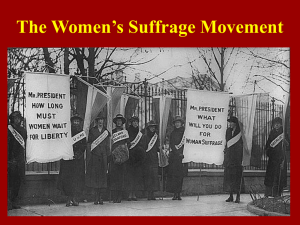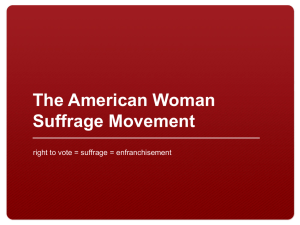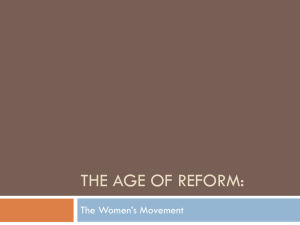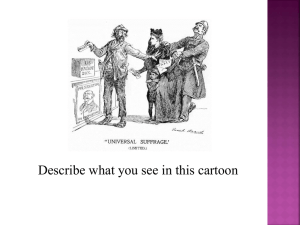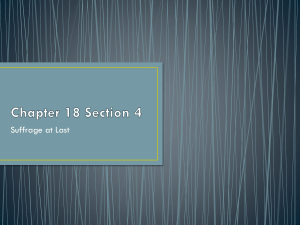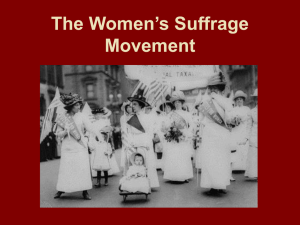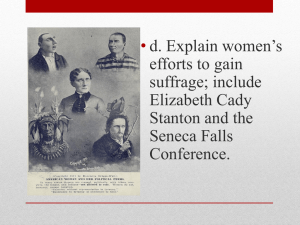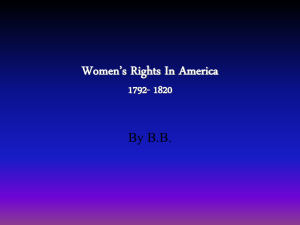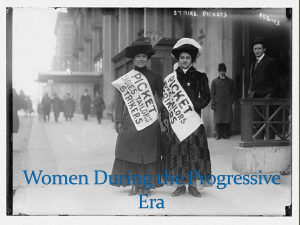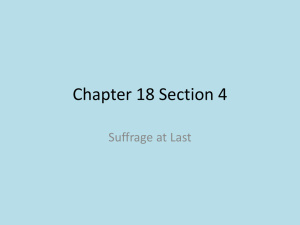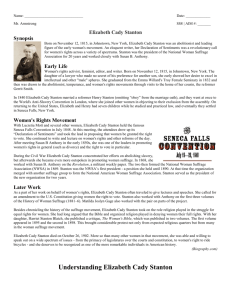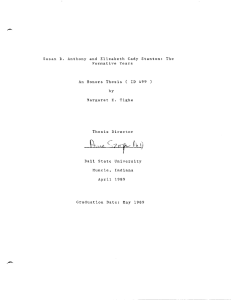Bibliography sources HISTH575
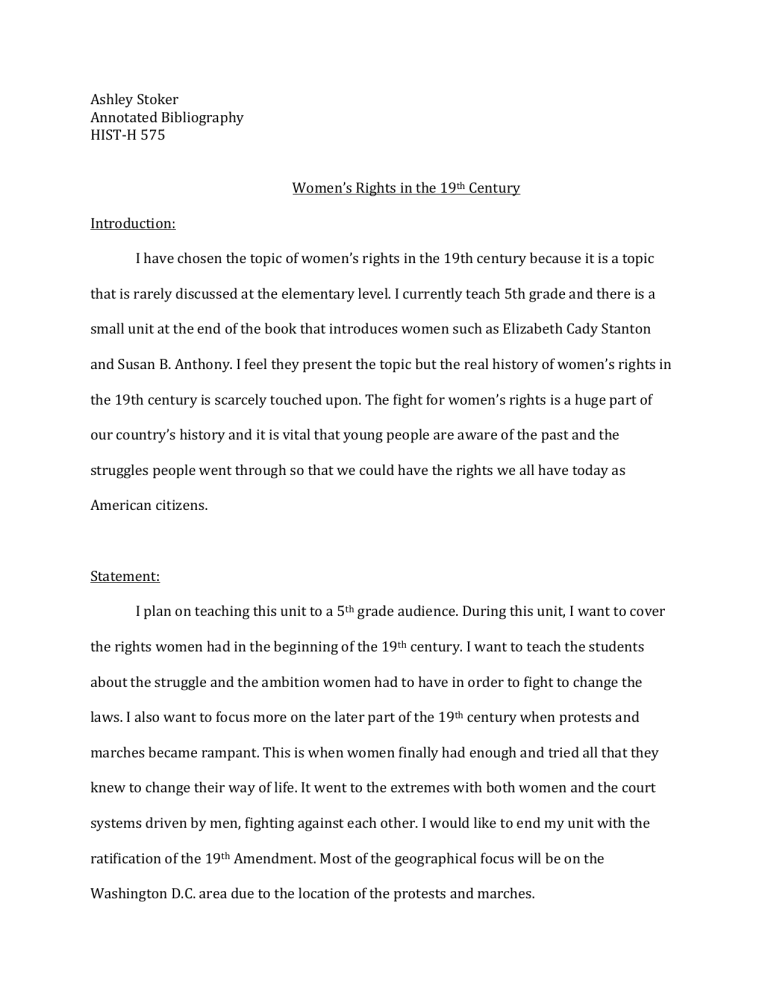
Ashley Stoker
Annotated Bibliography
HIST-H 575
Women’s Rights in the 19 th Century
Introduction:
I have chosen the topic of women’s rights in the 19th century because it is a topic that is rarely discussed at the elementary level. I currently teach 5th grade and there is a small unit at the end of the book that introduces women such as Elizabeth Cady Stanton and Susan B. Anthony. I feel they present the topic but the real history of women’s rights in the 19th century is scarcely touched upon. The fight for women’s rights is a huge part of our country’s history and it is vital that young people are aware of the past and the struggles people went through so that we could have the rights we all have today as
American citizens.
Statement:
I plan on teaching this unit to a 5 th grade audience. During this unit, I want to cover the rights women had in the beginning of the 19 th century. I want to teach the students about the struggle and the ambition women had to have in order to fight to change the laws. I also want to focus more on the later part of the 19 th century when protests and marches became rampant. This is when women finally had enough and tried all that they knew to change their way of life. It went to the extremes with both women and the court systems driven by men, fighting against each other. I would like to end my unit with the ratification of the 19 th Amendment. Most of the geographical focus will be on the
Washington D.C. area due to the location of the protests and marches.
Bibliography:
A History of the American Suffragist Movement . "Selected Documents from the Appendix." Sojourner
Truth's Speech to the Akron Convention, 1851. The Moschovitis Group, Inc. http://www.suffragist.com/docs.htm (accessed 04 21, 2011).
This is an article that gives Sojourner Truth's speech at the Akron Convention in
1851. It also has The Declaration of Sentiments from the Seneca Falls Convention in
1848. These documents could be used as background knowledge for the teacher or as documents you could show in class to intermediate aged students.
Anthony, Susan B. "Poem." Rochester: Rare Books University by Rochester Library.
This is a poem about suffrage written by Susan B. Anthony. This could be used in the classroom during the literacy portion of this unit. It could be used for upper elementary aged students to be able to understand and decode the feelings and voice
Susan B. Anthony presents. This would be good to build the students background knowledge in a different form of text.
Barber, E. Susan. National American Woman Suffrage Association Collection Home Page. National
American Woman Suffrage Association. http://memory.loc.gov/ammem/naw/nawstime.html
(accessed 04 21, 2011).
This is a timeline starting in 1776 and ending in 1923. It covers the important events that occurred during the fight for women's rights over the course of 147 years. This source could be used as background knowledge for a teacher or as a reference for students.
Boydston, Jeanne. Not For Ourselves Alone: The Story of Elizabeth Cady Stanton and Susan B. Anthony.
PBS. http://www.pbs.org/stantonanthony/resources/index.html?body=culthood.html (accessed
04 21, 2011).
This source goes along with a PBS film on fighting for women's rights. It is titled the
"Cult of True Womanhood" because of how the women stuck together and what daily life was like during this time period. This could be used as background knowledge for the teacher. The information here could be presented to the students before or after the film.
Cronicle, Rochester Democrat and. "Remarks by Susan B. Anthony in the Circut Court of the United
States for the Northern District of New Work ." The Elizabeth Cady Stanton & Susan B. Anthony
Papers Project, 1873: 1.
This is a document of remarks from Susan B. Anthony and the court at her trial for voting rights. This source would be a good form of background knowledge for the
teacher as well as an excellent way for the students to see what exactly was said. It would be a good resource for them to have while creating a literature piece to go along with this unit.
D.D., Rev. John Todd. Women's Suffrage: Their Rights and Nothing Less. Library of Congress. http://www.loc.gov/teachers/classroommaterials/lessons/women-rights/todd.html (accessed
04 21, 2011).
This source is a series of lesson plans on the suffrage movement. It gives background knowledge as well as lessons teaching it. This would be something that could be used in the classroom as an actual lesson for this unit. The lessons are designed for grades
6-8 as well as grades 9-12, both lasting two weeks.
Friedes, Jennifer. Iron Jawed Angels. Directed by Katja von Garnier. Produced by HBO Films. Performed by Hilary Swank. 2004.
Iron Jawed Angels is a film that could be used for background knowledge on the subject as well as a source that could be presented to the students. For upper elementary aged students, only clips would be appropriate. It is a good representation of what really happened and it would be good for students to have another source presented to them other than text.
Gordon, Ann D. "Google Documents; EBSCOHOST." Writing in the Lives of Women. 2002. https://docs.google.com/viewer?a=v&pid=gmail&attid=0.2&thid=12e9b69b89b3dd72&mt=appl ication/pdf&url=https://mail.google.com/mail/?ui%3D2%26ik%3Dd5fcb74d83%26view%3Datt%
26th%3D12e9b69b89b3dd72%26attid%3D0.2%26disp%3Dsafe%26zw&sig=AHIEtbQTsn_cG39C
UW6Adktvs7 (accessed March 1, 2011).
This document gives insight into the lives of the women who made a difference. It is a great source for teacher background knowledge. It could also be used as a source for high school age students. As for the elementary age, this source provides a lot of vital
information on what most history textbooks missed.
Hallowell, Anna Davis. James and Lucretia Mott:Life and Letters. Boston: Houghton Mifflin and
Company, 1890.
This source is a series of journal entries from James and Lucretia Mott discussing the suffrage movement. There are several chapters of letters in this book. The ones that would be beneficial for this project would include the chapters on women's rights, anti-slavery movement, Quakerism, and the discourse on women. This could be used for the instructor's background knowledge as well as the students. For older students it would be good to show them these actual letters and have them interpret them.
Hamm, Thomas D. "Quakerism, Ministry, Marriage, and Divorce." Google Documents. September 2008. https://docs.google.com/viewer?a=v&pid=gmail&attid=0.6&thid=12e9b69b89b3dd72&mt=appl ication/pdf&url=https://mail.google.com/mail/?ui%3D2%26ik%3Dd5fcb74d83%26view%3Datt%
26th%3D12e9b69b89b3dd72%26attid%3D0.6%26disp%3Dsafe%26zw&sig=AHIEtbRa9NXR_i_-
R5Y3XPGVhn (accessed March 1, 2001).
This document is a good source to use with this project if you are planning on teaching the Quaker religion along with it. Quakers had a lot to do with the suffrage women as well as the anti-slavery movement during this time period. This document gives knowledge on the Quaker religion. It would be helpful background knowledge for an elementary teacher.
Kamma, Anne. If You Lived When Women Won Their Rights. New York: Scholastic Inc., 2008.
If You Lived When Women Won Their Rights is a trade book that takes students back into the time of fighting for women's rights. This is a book that would be good to use for grades 3-6 as a way to engage or hook the students into the lesson. It compares life of women back then to people their age now. This story tells the story of what women went through.
Christina Kirk: Susan B. Anthony. Directed by History Channel. Produced by http://www.history.com/topics/the-fight-for-womens-suffrage/videos#the-people-speak-3.
Performed by Christina Kirk and Josh Brolin.
This is a video clip of a women reciting what Susan B. Anthony said at her trial. It would be good to combine this source with the written words of her trial and present it to students through the technology format to appeal to auditory learners as well as visual learners. This could be used for any age but it would probably be targeted for grades 3-6.
Library of Congress. Teacher's Guide Primary Source Set. Library of Congress. http://www.loc.gov/teachers/classroommaterials/primarysourcesets/womenssuffrage/pdf/teacher_guide.pdf (accessed 04 21, 2011).
This source gives a brief historical background of women's suffrage as well as suggestions for teachers. It is also rich with visual sources to use in a lesson. Each of the images that are attached has a link that explores the topic deeper. This would be good to provide a vast amount of visual images to students as well as engaging creative activities to do with the unit.
"Photograph of Suffragist with "Kaiser Wilson" Poster."
http://www.archives.gov/education/lessons/woman-suffrage/kaiser-wilson.html. 04 21, 2011.
This is an image of a lady holding one of the signs used outside of the White House.
This would be a good hook to use with elementary aged students so they are able to make a connection to what they are learning. The wording is powerful.
Prinkey, Andrea Davis. Let It Shine. Harcourt Children's Books; 1st edition , 2000.
This source is a children's book about freedom fighters. It is composed of African
American women. It would be helpful when introducing Harriet Tubman to the children. It gives the students background knowledge and would be most appropriate for elementary aged students.
One Woman, One Vote. Produced by PBS. Performed by Susan Sarandon. 2006.
This film documents the fight of passing the 19th amendment. It shows films from that time period as well as important icons for women's rights. This film would be most appropriate for upper elementary through high school age students. The film
could be used for students' or the instructor's schema.
Suffrage and the Women Behind It. Produced by History Channel. Performed by Picture Slide Show. http://www.history.com/topics/the-fight-for-womens-suffrage/photos#suffrage-and-thewomen-behind-it.
This slide show of important women helps students to put a face with a name when learning about the women's suffrage leaders. It is a slide of 7 pictures that help students connect to the topic. It could be used for any age.
Stanton, Elizabeth Cady. The Woman's Bible: A Classic Feminist Perspective. New York: Dover
Publications, 2002.
Elizabeth Cady Stanton published this book as a focus on the journey and struggle women during the late 19th century. She took the bible and used scriptures to prove the necessity of equality. This is an excellent source for background knowledge for the teacher considering it is from one of the actual leaders and it is in a different format that some books.
Swain, Gwenyth. The Road to Seneca Falls: A Story About Elizabeth Cady Stanton. Lerner Classroom 1st
Edition, 1996.
This children's book is a biography of Elizabeth Cady Stanton. It uses entries from her diary, letters and presents information in a story format. The targeted age for this book would be grades 3-6. This book could be used to build the students background knowledge on Elizabeth Cady Stanton, creating a biography or engaging the students.
Time Magazine. "In Time Lead, Follow Or Get Out Of the Way." Iron Jawed Angels. HBO. 2003. http://www.time.com/time/classroom/voting/pdfs/student.pdf (accessed 04 21, 2011).
This document is a Time Magazine for students article covering comparisons of history to the Iron Jawed Angels movie. It helps students to make connections as well as explaining a lot of the reasons on why the women did certain things. This could be used for any older age group with or without the movie. It could be used in reading groups as an implementation to the lesson.
—. "Time Learning Ventures." Teacher’s Guide to Accompany HBO Films’ Iron Jawed Angels. HBO. 2003. http://www.time.com/time/classroom/voting/pdfs/teacher.pdf (accessed 04 21, 2011).
This document is very similar to the previous but it is geared toward teachers. It gives background knowledge that should be presented to the students as well as guided questions to ask the students before or after viewing the film. It also gives several connecting activities such as writing prompts. It is an excellent source for a teacher's background knowledge as well as guiding instruction.
Truth, Sojourner, Olive Gilbert, and Theodore D. Weld. The Narrative of Sojourner Truth. Boston: The
Author, 1880.
This book is narrative on Sojourner Truth. It is primarily used for teacher's background knowledge at the elementary level. It gives information about her so that the teacher will be able to bring knowledge of Sojourner Truth to the students and te ach about her role with fighting for women's rights.
"Woman Suffrage Handbill." http://madmikes.madmikesamerica.netdna-cdn.com/wp-
content/uploads/2010/09/Woman-Suffrage-Handbill-1912-FSDM2.jpg. 04 21, 2011.
This is an actual picture of a handbill used in 1912 persuading people to vote for women to have rights. This would be interesting to show to students of any age so that they are able to make a visual connection to the time period and what was actually happening. It could be used as a hook into the lesson.
"Women Marching in Front of White House." http://www.google.com/imgres?imgurl=http://wikihistoria.wikispaces.com/file/view/doc_063b
_big.jpg/51041839/doc_063b_big.jpg&imgrefurl=http://wikihistoria.wikispaces.com/Nineteenth
%2BAmendment&usg=__25iWD2ByqVU9HYlhEwUz8ctihwM=&h=388&w=500&sz=53&hl=en&st art=214&sig2=IgpGjl0EcxevD3qSCAnA3g&zoom=1&tbnid=OmAHbjCJx9_LWM:&tbnh=138&tbnw
=182&ei=NXC3TevqKIfAgQf09MVa&prev=/search%3Fq%3Dwomens%2Bsuffrage%26hl%3Den%2
6biw%3D1205%26bih%3D620%26site%3Dsearch%26tbm%3Disch0%2C5478&um=1&itbs=1&iact
=hc&vpx=132&vpy=204&dur=80&hovh=198&hovw=255&tx=156&ty=136&page=12&ndsp=19&v
ed=1t:429,r:7,s:214&biw=1205&bih=620. http://www.google.com/imgres?imgurl=http://wikihistoria.wikispaces.com/file/view/doc_063b
_big.jpg/51041839/doc_063b_big.jpg&imgrefurl=http://wikihistoria.wikispaces.com/Nineteenth
%2BAmendment&usg=__25iWD2ByqVU9HYlhEwUz8ctihwM=&h=388&w=500&sz=53&hl=en&st art=214&sig2=IgpGjl0EcxevD3qSCAnA3g&zoom=1&tbnid=OmAHbjCJx9_LWM:&tbnh=138&tbnw
=182&ei=NXC3TevqKIfAgQf09MVa&prev=/search%3Fq%3Dwomens%2Bsuffrage%26hl%3Den%
26biw%3D1205%26bih%3D620%26site%3Dsearch%26tbm%3Disch0%2C5478&um=1&itbs=1&ia ct=hc&vpx=132&vpy=204&dur=80&hovh=198&hovw=255&tx=156&ty=136&page=12&ndsp=19
&ved=1t:429,r:7,s:214&biw=1205&bih=620, 04 21, 2011.
This website contains several photos. There is one of women marching in front of the
White House, a flyer announcing Susan B. Anthony's trial, a poster mocking a previous poster sent out to persuade women to work, and a photo of women protesting in a march. Any of these photos could be used for any age with some explanation or guided conversation starters.
"Women Suffrage Banners." http://www.google.com/imgres?imgurl=http://www.old- picture.com/american-legacy/007/pictures/Suffrage-Banners-
Woman.jpg&imgrefurl=http://www.old-picture.com/american-legacy/007/Suffrage-Banners-
Woman.htm&usg=__M79WaWG7U8Afxyi36w6GYWldHPM=&h=465&w=632&sz=60&hl=en&sta rt=289&sig2=ertc3d7Wf29BsdtK4PrG-
Q&zoom=1&tbnid=H5OHbduO04CR8M:&tbnh=135&tbnw=186&ei=OHO3TYrPM8jDgQeSu-
Rr&prev=/search%3Fq%3Dwomens%2Bsuffrage%26start%3D233%26um%3D1%26hl%3Den%26 biw%3D1205%26bih%3D620%26output%3Dimages_json%26tbm%3Disch1%2C7261&chk=sbg&u m=1&itbs=1&iact=hc&vpx=503&vpy=401&dur=95&hovh=138&hovw=188&tx=94&ty=50&page=
16&ndsp=19&ved=1t:429,r:9,s:289&biw=1205&bih=620. 04 2011, 2011.
This is a picture of women protesting rights for the women that were arrested. This would be a great source to use with the Iron Jawed Angels film. It could be shown after the film and used as writing prompt for the literacy portion of the unit.
(Hallowell 1890) (Stanton 2002) (Truth, Gilbert and Weld 1880) (Cronicle 1873, 1)
(Anthony n.d.) (Swain 1996) (Prinkey 2000) (Gordon 2002) (Hamm 2008) (Kamma 2008)
(Time Magazine 2003) (Library of Congress n.d.) (Time Magazine 2003) (Barber n.d.) (Kirk and Brolin n.d.) (Friedes 2004) (Show n.d.) (Boydston n.d.) (Sarandon 2006) (A History of the American Suffragist Movement n.d.) (D.D. n.d.) (Women Marching in Front of White
House 2011) (Photograph of Suffragist with "Kaiser Wilson" Poster 2011) (Woman
Suffrage Handbill 2011) (Women Suffrage Banners 2011) (Photograph of Suffragist with
"Kaiser Wilson" Poster 2011)
Conclusion:
I have learned that the human condition of the 19 th century was much different for men and women. Throughout the 19 th century, the idea of morals played a huge role in the society of men and women. Morals were set for each gender that laid a projected path for both genders. Men were given choice, freedom, and power in the American society. Women on the other hand were expected to fill the position of housewives including of the typical domestic duties of that time.
Later in the 19 th century, women began to enter the working force filling the lowest paying positions. Men still dictated women in the work force demanding work under hazardous conditions and long hours. Along with the power of men, came the power of money. Money dictated most of everything as many people could argue it does today.
Money was the driving force behind all situations and that did not make being a woman any easier.
Women everywhere in the United States began working together in groups to help fight for women’s rights. Women had little to no rights during the 19 th century. They couldn’t even vote to help determine which man would lead our country. The great suffrage leader, Susan B. Anthony said at her trial, “by forms of law all made by men, interpreted by men, administered by men, in favor of men, and against women” was said to point out how male centered and unfair the economy was. Courage and strength shown by women such as
Elizabeth Cady Stanton and Susan B. Anthony is what it took to start a movement that would forever change the forefront of the United States. The agency taken by these women is what will forever heal the holes in our country’s past of inequality of men and women.
